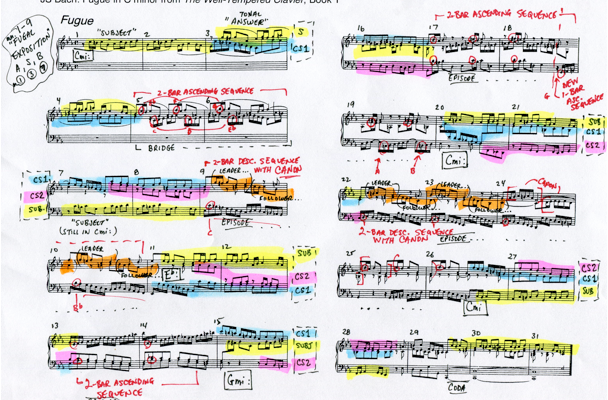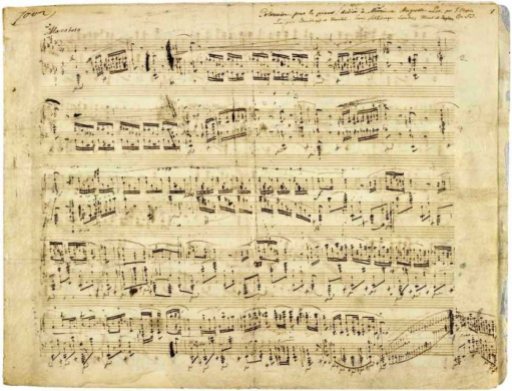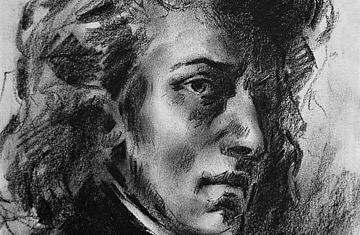Romantic Sheet Music
Virtuosity & Piano Artistry

In the sphere of piano performance or piano artistry there are few human activities where the necessity for extraordinary physical prowess is so closely aligned with the greatest intellectual and emotional capacities.
The virtuoso must possess a memory capable of maintaining thousands of pages of music in the mind and fingers, under the stress and distractions of public performance; the virtuoso must be cultured and self-aware, musically able to convey the great range of meaning embodied within a chosen repertoire; the virtuoso must project both physical excitement and emotional communication; and the virtuoso must experience life to the fullest while remaining cloistered with an instrument in a relentless quest to maintain his or her craft at its highest level.
http://www.theartofpianoperformance.com/
Attributes & Depth Required to Interpret Chopin
A capricious, even morbid, temperament is demanded, and there must be the fire that kindles and the power that menaces; a fluctuating, wavering rhythm yet a rhythmic sense of excessive rectitude; a sensuous touch, yet a touch that contains an infinity of coloring; supreme musicianship-Chopin was a musician first, poet afterwards; a big nature overflowing with milk and honey; and, last of all, you must have suffered the tribulations of life and love, until the nerves are whittled away to a thin sensitive edge and the soul is aflame with the joy of death’ James Huneker
Study Piano Performance in Boca Raton & West Palm Beach
Optimize Your Piano Practice Time
Practice Tips for Developing a Solid Technique in Piano Performance
Practicing is both an art and a science. Every student of piano performance must remember that their achievement on the instrument will be the direct result of the amount of time and the quality of their practicing.
The art and science of practicing is not just time spent at the instrument but time spent listening to the music the student is working on, studying and understanding the harmonic analysis of the music as well as researching the time period and technical characteristics of the composer of the piece you are working on.
In addition to this, it is advisable for the student to prepare a weekly plan outlining the time spent on specific techniques, repertoire, sight-reading and review of old or previously learned repertoire.
Technique
The purpose of technique is to serve the pianist’s imagination and realize his/her interpretive ideas…
View original post 201 more words
Study Piano Artistry Online with Google +

Toccata BWV 915 by Johann Sebastian Bach
Toccata BWV 915
The toccata an extensive piece intended primarily as a display of manual dexterity written for keyboard instruments reached its apex with Johann Sebastian Bach in the eighteenth century. Johann Sebastian Bach’s seven Toccatas incorporate rapid runs and arpeggios alternating with chordal passages, slow adagios and at least one or sometimes two fugues. The Toccatas have an improvisational feel to them analogous to the fantasia. Unlike the Well Tempered Clavier, English suites, French suites and other sets, Bach himself did not arrange them into a collection. When JS Bach left Weimar the Toccata at that time was out of fashion. They became in vogue again after his death and were organized into a collection. The g minor Toccata is one of the more obscure of the toccatas and has rarely been performed partially due to the extensive second fugue with its many thorny passages of the contrasting gigue rhythm. However, this Toccata has many fascinating effects. It is one of the only pieces by JS Bach that has dynamic markings of piano and forte.
The g minor Toccata opens with a flourish, which leads into an expressive adagio with an improvisational feel. The adagio is interrupted by a lively allegro in the relative major key of Bb which includes concerto-ritornello passages of imitation and solo/tutti passages. A deceptive cadence leads back into the adagio where it was interrupted and then closes the adagio with a perfect authentic cadence in Bb major. This aspect provides a unity to the different movements of the Toccata. The other striking example of unity between movements is the beginning flourish repeated at the end of the second fugue, which leads into a formal closing of the work.
The extended fugue in a gigue has a subject of an ascending sequence combined with a countersubject of driving triplets. The subject of the fugue has twelve expository entries followed by eleven entries. There are inversions, permutations, combinations of minor with major, which is varied by modulating to the subdominant, then to Eb major and then back to the g minor tonic. The vivacious counter subject of driving triplets provides a symmetrical balance.
To learn more about Fugues please read my other Hub: The Art of Fugue
http://jamilasahar.hubpages.com/hub/The-Art-of-Fugue
For More Information on Piano Lessons in Boca Raton or Via Skype:
Optimize Your Piano Practice Time
Practice Tips for Developing a Solid Technique in Piano Performance
Practicing is both an art and a science. Every student of piano performance must remember that their achievement on the instrument will be the direct result of the amount of time and the quality of their practicing.
The art and science of practicing is not just time spent at the instrument but time spent listening to the music the student is working on, studying and understanding the harmonic analysis of the music as well as researching the time period and technical characteristics of the composer of the piece you are working on.
In addition to this, it is advisable for the student to prepare a weekly plan outlining the time spent on specific techniques, repertoire, sight-reading and review of old or previously learned repertoire.
Technique
The purpose of technique is to serve the pianist’s imagination and realize his/her interpretive ideas on the instrument. The pianist should be able to have complete control of their fingers. In order to achieve this we have to train them so they will do whatever we want them to do to serve the pianists imagination. Technique and interpretation are interwoven.
Listening
Just as technique and interpretation are interwoven, reading musical scores and listening to music are equally important and interwoven. The art of listening to one’s own playing can be acquired first by listening to other pianists. Piano students need to learn to listen to other performances on a deeper level, following musical ideas and subtle nuances which the student may or may not incorporate in their own performances.
Music Theory
Just as technique and interpretation are interwoven and listening and reading are interwoven, understanding music scientifically or music theory and memorization are deeply interwoven. The human mind can best retain things it understands, things that ‘make sense’. If we understand something musically, understand the musical structure of the piece the student is well on the way to memorizing and a solid performance. With this being accomplished the pianist is then able to use their technique to serve their imagination and deliver an inspired performance.
Piano Lessons in Boca Raton































